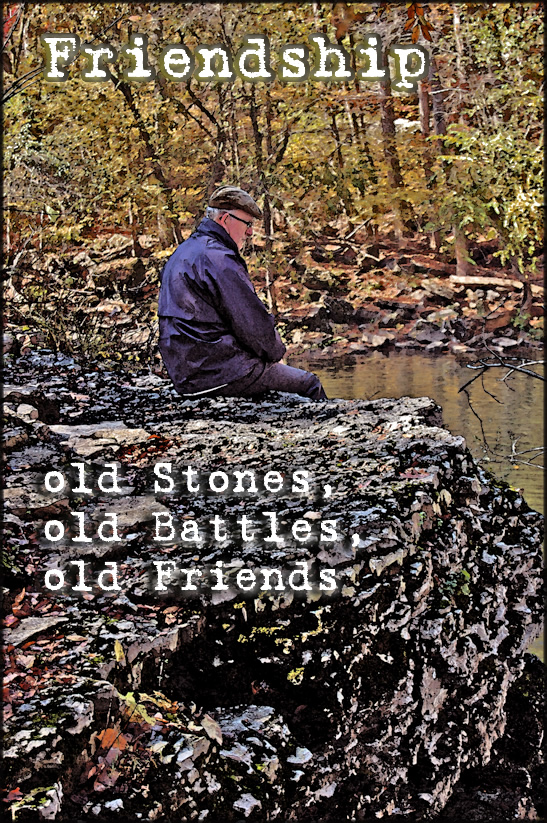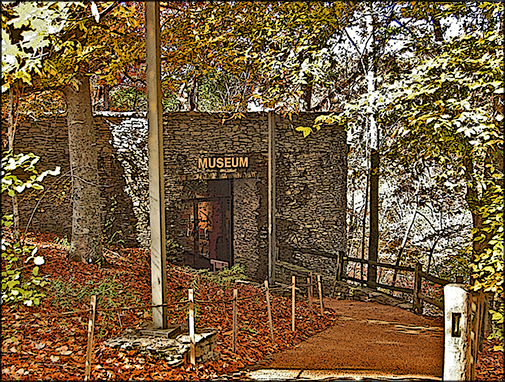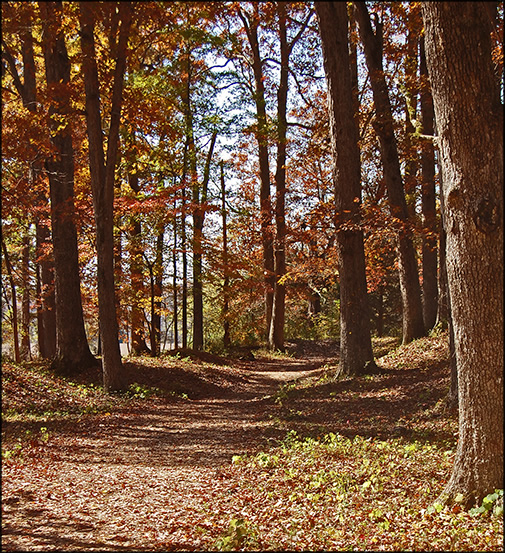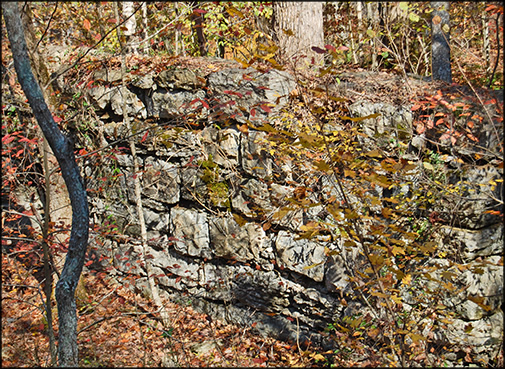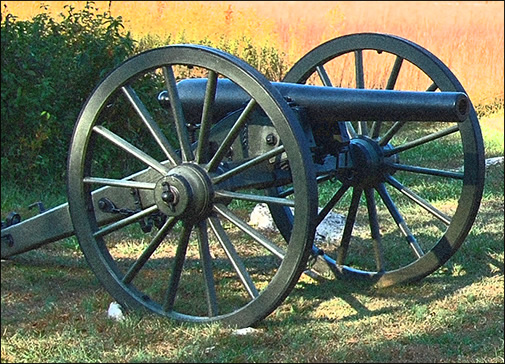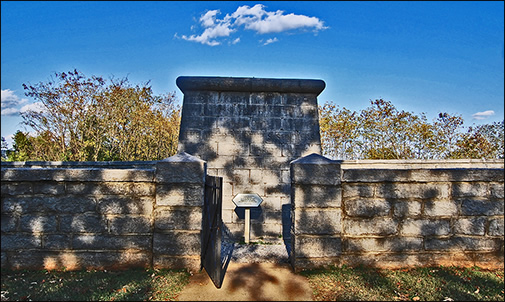|
Jeremy Black at Old Stone Fort Park in Tennessee
Photo by Ron Fritze ~ October 29, 2011
Mounds, Madoc, the Slick Pig,
and a Civil War Battlefield Park:
Peregrinating
With Jeremy Black
By Ron Fritze from Athens, Alabama
Filed on October 31, 2011
Posted on April 20, 2012
Jeremy Black visited the Athens State University campus last autumn to deliver a lecture, The Politics of James Bond, a subject about which he has written a book. It was a good talk, entertainingly delivered with lots of interesting insights and anecdotes. Jeremy, a good friend, stayed at my home. In our planning we had set aside a Saturday to do a road-trip. I suggested that we drive up to Manchester, Tennessee, to visit the Old Stone Fort Park and then head up to Murfreesboro to explore the Stones River Battlefield Park. Jeremy is a military historian and had never been to Stones River, so he was up for the trip.
Starting the day with a nice breakfast, we left my home south of Athens a bit after 9 o’clock, motoring up I-65. Problem: Jeremy and I talk non-stop. Result: I missed the exit to our first destination at Lynchburg, the famous home of Jack Daniels. Solution: We traveled about ten miles further north and had to cut back cross-country on the side roads. It turned out just fine as we saw a lot of pleasant rolling hills and wooded countryside. Passing the Jack Daniels distillery, we elected not to stop. Lynchburg is dry . . . Yes, I said dry! You can buy a souvenir bottle of the product, but that's it. We weren’t interested.
In a little while we reached Manchester. To reach Old Stone you have to drive through a considerable stretch of densely populated area, tempting one to think they might have missed the park entrance. I had been there five years earlier so I knew we had to keep driving.
Visitors Center at Old Stone Fort Park
You'll Have to Look Elsewhere
To Find the Landing Base
For Ancient Aliens.
Old Stone Fort Park has a camping area and various hiking paths, but we wanted to see the ancient works. The smartly done visitors center features thoughtful and attractive displays with excellent information about the various phases of pre-Columbian Native American cultures. Like many Moundbuilder complexes, Old Stone Fort has been identified by some as a fortification built by Prince Madoc of Gwynned’s people about 1200. Others have suggested the Vikings. Neither is true, but it would be nice for the visitor’s center to devote a modest display to discussing the myth of Madoc and the Welsh Indians — and then debunking it.
I know from personal experience that the Tennessee Park Service staff are well aware of the Madoc myth. During my first visit there I discussed it with the very knowledgeable female ranger who was working the information desk that day. She also told me that the Visitor Center library has a pretty good collection of Madoc related books. It’s a different story at the center’s bookstore. Although they sell a wide variety of texts about the archaeology and anthropology of North America and the Southeast, they don’t carry any Madoc books. In my opinion, the Tennessee Park Service, along with other park services, needs to recognize the existence of myths and educate the public that stories like Madoc are well and truly myths, not history.
Once outside, we walked the area containing the mound complex. Old Stone Fort is not a big, hill-like mound shaped like a pyramid. The pyramid-shaped temple mounds are characteristic of the Mississippian culture of North America that flourished from 800-1500 AD. Old Stone Fort is a Middle Woodland mound about 2,000 years old. Archaeologists think it was built over a period of up to 400 years between the dates of 40-400 AD. The Woodland culture is also referred to as the Hopewell Culture, whose peoples built burial mounds and ceremonial mounds. Old Stone Fort is a ceremonial mound with an astronomical alignment that is only partially understood — but definitely not a landing base for ancient aliens.
Ceremonial Entrance to Old Stone Fort
For the Spirit and Not for War
The name Old Stone Fort derives from the assumption of early American settlers that it was an abandoned fort. Its location contributes to this assumption. The mound works are located on a high bluff on a peninsula formed by the coming together of the Big Duck and Little Duck Rivers. Ancient Native Americans built an earthen wall with a stone core around the perimeter of the bluff. The earthen wall is not very tall and would not have deterred attackers. This bears out the suggestion that the mound complex was ceremonial.
Leaving the visitor center, we passed through a series of mounds forming an entry way. Once this gateway was passed, we entered a large meadow that served as the ceremonial center. But the park’s path takes visitors around the perimeter of the mound wall. The path covers a mile and quarter with various side paths that can be explored at the discretion of the visitor.
Jeremy and I followed the main path and took most of the diversions as well. The autumn leaves were beginning to change into red and yellow hues, providing a mellow contrast to the lingering green of summer — not the best of fall colors, given the absence of a heavy frost to date, but nevertheless becoming to the eye. There were other people walking the path, which was rougher and more rutted than I remembered from my first visit. Later I checked with the park ranger, and she confirmed there had been some erosion due to the drought retarding ground cover plants. About three-quarters around the mound wall, we climbed down to take a look at Big Falls and Blue Falls on the Big Duck River. The whooshing sound from the falling water was peaceful and relaxing.
Ruins of the Hickerson and Wooten Paper Mill
This Paper Trail
Leads Away from Madoc.
Next along the path was the Hickerson and Wooten Paper Mill. The surviving ruins of the mill are mostly walls of rough stones. Initially, given that the first wall was overgrown with moss and other vegetation, I wasn’t sure whether it was natural or man-made. With so much shale in the geology of this part of the Big Duck River, you see a lot of stones with straight lines, and some of the formations have the appearance of steps. A look on the other side of that first wall made it clear that the structure was man-made. Of course, for a convinced Madocian, the structure could have been all that was left of a Welsh castle keep. Unfortunately for that same convinced Madocian, the existence of the paper mill is too well documented for an interpretation of the ruins as medieval Welsh to be the even the slightest bit credible.
Soon we were back at the visitor center and anxious to get on the road again. With I-24 nearby, we were swiftly on our way to the Slick Pig on East Main in Murfreesboro near the Middle Tennessee State University campus. The barbeque joint was highly recommended to us by Bob and Laurie Glenn.
The Slick Pig is an unprepossessing place with marvelous food. We tried wings and coleslaw, both extremely good. I’ll be stopping there again at the first opportunity — and I suggest you do the same. Jeremy is a fan of non-chain American food, and he would second my recommendation most heartily. He would also inform you (and I can back him up on this) that barbeque is non-existent in England. One caution though, based on the political things posted on the walls: I suspect Rush Limbaugh would love the place. Hey, that’s what makes America a great country. Everybody gets to have any opinion they want. Some, like Rush, even get to bray daily on talk radio.
You Won't Find this Pig in England.
You Know, It's the Place
With the Big Old Cannons....
Next we made our way to the Stones River Battlefield Park. The owner of the Slick Pig gave us good directions, which were rendered for naught by a train parked on the tracks and blocking the street we needed cross. Trying an alternate route, we asked a couple of teen-aged boys for directions, which were distressingly vague and tentative. These two were clearly not fascinated by the history of their hometown. Later, seeing a gas station, I pulled in and filled up. Uncharacteristically, I asked for more directions (someone help Twylia, she’s fainted!) from the teenager with a pony-tail who was manning the cash register. He seemed brighter than the other two guys but confessed to be ashamed to not know for sure. After a bit of discussion, we came to an agreement that the battlefield park was the place with the cannons and a military cemetery. That got him focused. His directions were good, helped by the fact we were almost there anyway. Still, the history teachers of Murfreesboro have a lot to answer for. Those kids don’t seem to know much about the most significant event in their town’s history. O tempora, o mores!
The Stones River Battlefield Park has a very good visitor’s center. We went through the exhibits and got a map from the ranger at the information desk. My ancestor, Jacob Spräu, served with the 101st Ohio Volunteer Infantry Regiment, which fought its second battle of the war at Murfreesboro. It was not a good day for them. They were on picket duty when the Confederate Army attacked. A portion of their position was overrun, resulting in the capture of a goodly number of the regiment. I have looked through the 101st’s regimental history. Its roster is peppered with references to members who were paroled or sent to Libby or Andersonville prisons. Many of those in the prisoner of war camps died there. Jacob avoided that fate and also managed not to get wounded. Later, he would not be so lucky. At Chickamauga and Missionary Ridge he was wounded in both of those battles.
A Union Cannon on Display at Stones River.
This Pajama Party Turned Sour.
The 101st’s problem was part of the general problem that bedeviled the Union Army for most of the first day of the Battle of Stones River on 31 December 1862. The Confederate Army attacked the Union Army’s right flank, consisting of Alexander McCook’s Corps, and rolled it back, including the 101st. Embarrassingly, the Union troops were caught at breakfast. Some were in pajamas, repeating a lack-of-readiness problem that characterized two earlier Union near-disasters at Fort Donelson and Shiloh.
Eventually, Confederate forces encountered stubborn rearguard resistance that blunted their attack. Meanwhile, William B. Hazen’s brigade held its ground, making it the only Union unit to stand fast that day. The rest of the Union right flank was bent back to the right of Hazen’s. There, some 30,000 Union troops with cannons lined up and finally halted the Confederate attack with massive firepower. With both sides suffering heavy casualties, Confederate commander Braxton Bragg expected Union commander William Rosecrans to retreat to Nashville. Instead, much to Bragg’s surprise, Rosecrans held his ground.
Confederate attacks on the following days failed to move the Union position, while a Union counter-attack forced part of the left wing of the Confederate Army out of its position. Bragg withdrew from the battlefield, leaving Rosecrans the technical victory. When it was over, the battle left 23,000 soldiers of both sides killed, wounded, or captured. At a tactical level the Battle of Stones River was a draw. Strategically, it gave the Union cause a big morale boost.
The Hazen Monument
They Held Their Ground.
Much of the battlefield of Stones River is located on private property. The ill-fated 101st Ohio’s original position is located on such private land to the west of the park. The bulk of the current battlefield park is focused on the area where Hazen’s brigade held their ground and where the rest of the Union right flank took up their final position and stopped the Confederate advance. The Park Service is buying more land. They are also adding to the facility.
Jeremy and I walked a circuit path around the existing battlefield park that is very nice and pretty well marked, although some detailed maps of the battle would be helpful. Lots of people were walking the path that day including joggers and dog-walkers. It was a pleasant, sunny day. After finishing the circuit, we visited the monument erected by Hazen’s Brigade, which is purported to be the oldest surviving Civil War memorial. The Stones River Battlefield Park is constantly improving. If you have never visited the park, I strongly recommend checking it out. It is worth a visit. And if five or more years have passed since your last visit, I suggest giving it another look. A lot has changed.
Our route back home to Huntsville followed a scenic path along country roads, capping a very nice day. The interesting and unexpected development was that Old Stone Fort beat out Stones River as Jeremy’s favorite. We both liked the Slick Pig and I suspect will nostalgically recall the fine food until we get to try it again. Gotta go.

Jeremy Black
October 29, 2011
E D I T O R ' S N O T E :
Ron's friend Jeremy Black is one of the most prolific and accomplished writers of history in our age. A professor at the University of Exeter, Jeremy is a senior fellow at the Center for the Study of America and the West at the Foreign Policy Research Institute. A Member in The Most Excellent Order of the British Empire, he is the author of over one hundred books. The linked image below will take you to Professor Black's web:

|



